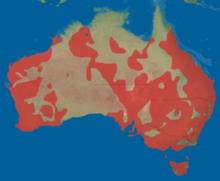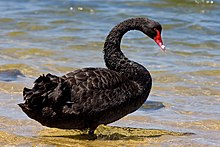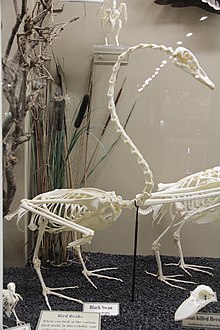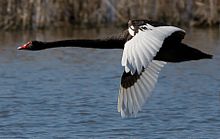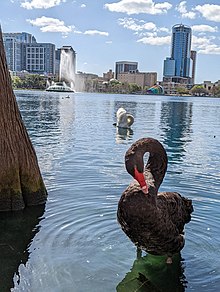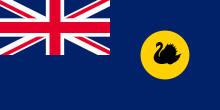
Swans are birds of the genus Cygnus within the family Anatidae. The swans' closest relatives include the geese and ducks. Swans are grouped with the closely related geese in the subfamily Anserinae where they form the tribe Cygnini. Sometimes, they are considered a distinct subfamily, Cygninae.

The brolga, formerly known as the native companion, is a bird in the crane family. It has also been given the name Australian crane, a term coined in 1865 by well-known ornithologist John Gould in his Birds of Australia.

The freckled duck is a waterfowl species endemic to Australia. The freckled duck has also been referred to as the monkey duck or oatmeal duck. These birds are usually present in mainland Australia, but disperse to coastal and subcostal wetlands in the dry period. During such times it is common for the freckled duck population to congregate in flocks in the same area, giving the impression that they are more common than they really are.

The tundra swan is a small swan of the Holarctic. The two taxa within it are usually regarded as conspecific, but are also sometimes split into two species: Bewick's swan of the Palaearctic and the whistling swan proper of the Nearctic. Birds from eastern Russia are sometimes separated as the subspecies C. c. jankowskii, but this is not widely accepted as distinct, with most authors including them in C. c. bewickii. Tundra swans are sometimes separated in the subgenus Olor together with the other Arctic swan species.

The black-necked swan is a species of waterfowl in the tribe Cygnini of the subfamily Anserinae. It is found in Argentina, Brazil, Chile, Uruguay, and the Falkland Islands.

The whooper swan, also known as the common swan, is a large northern hemisphere swan. It is the Eurasian counterpart of the North American trumpeter swan, and the type species for the genus Cygnus.

The Dalmatian pelican is the largest member of the pelican family, and perhaps the world's largest freshwater bird, although rivaled in weight and length by the largest swans. They are elegant soaring birds, with wingspans rivaling those of the great albatrosses, and their flocks fly in graceful synchrony. With a range spanning across much of Central Eurasia, from the Mediterranean in the West to the Taiwan Strait in the East, and from the Persian Gulf in the South to Siberia in the North, it is a short-to-medium-distance migrant between breeding and overwintering areas. No subspecies are known to exist over its wide range, but based on size differences, a Pleistocene paleosubspecies, P. c. palaeocrispus, has been described from fossils recovered at Binagady, Azerbaijan.

The ruddy shelduck, known in India as the Brahminy duck, is a member of the family Anatidae. It is a distinctive waterfowl, 58 to 70 cm in length with a wingspan of 110 to 135 cm. It has orange-brown body plumage with a paler head, while the tail and the flight feathers in the wings are black, contrasting with the white wing-coverts. It is a migratory bird, wintering in the Indian subcontinent and breeding in southeastern Europe and central Asia, though there are small resident populations in North Africa. It has a loud honking call.

The purple gallinule is a swamphen in the genus Porphyrio. It is in the order Gruiformes, meaning "crane-like", an order which also contains cranes, rails, and crakes. The purple gallinule is a rail species, placing it into the family Rallidae. It is also known locally as the yellow-legged gallinule. The specific name martinica denotes "of Martinique".

The cotton pygmy goose or cotton teal is a small perching duck which breeds in Asia, Southeast Asia extending south and east to Queensland where they are sometimes called white-quilled pygmy goose. They are among the smallest waterfowl in the world and are found in small to large waterbodies with good aquatic vegetation. They are usually seen in pairs or larger groups of pairs, roosting and nesting on trees near water. They are strong fliers and are known to disperse widely, especially in winter. Their breeding season coincides with the rains.

The New Zealand swan is an extinct indigenous swan from the Chatham Islands and the South Island of New Zealand. Discovered as archaeological remains in 1889, it was originally considered a separate species from the Australian black swan because of its slightly larger bones, and swans not having been introduced to New Zealand until 1864. From 1998 until 2017, it was considered to be simply a New Zealand population of Cygnus atratus, until DNA recovered from fossil bones determined that it was indeed a separate species, much larger and heavier than its Australian relative.
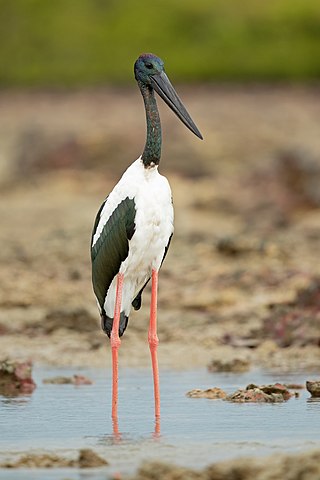
The black-necked stork is a tall long-necked wading bird in the stork family. It is a resident species across the Indian Subcontinent and Southeast Asia with a disjunct population in Australia. It lives in wetland habitats and near fields of certain crops such as rice and wheat where it forages for a wide range of animal prey. Adult birds of both sexes have a heavy bill and are patterned in white and irridescent blacks, but the sexes differ in the colour of the iris with females sporting yellow irises and males having dark-coloured irises. In Australia, it is known as a jabiru although that name refers to a stork species found in the Americas. It is one of the few storks that are strongly territorial when feeding and breeding.

The trumpeter swan is a species of swan found in North America. The heaviest living bird native to North America, it is also the largest extant species of waterfowl, with a wingspan of 185 to 304.8 cm. It is the American counterpart and a close relative of the whooper swan of Eurasia, and even has been considered the same species by some authorities. By 1933, fewer than 70 wild trumpeters were known to exist, and extinction seemed imminent, until aerial surveys discovered a Pacific population of several thousand trumpeters around Alaska's Copper River. Careful reintroductions by wildlife agencies and the Trumpeter Swan Society gradually restored the North American wild population to over 46,000 birds by 2010.

The fulvous whistling duck or fulvous tree duck is a species of whistling duck that breeds across the world's tropical regions in much of Mexico and South America, the West Indies, the southern United States, sub-Saharan Africa and the Indian subcontinent. It has plumage that is mainly reddish brown, long legs and a long grey bill, and shows a distinctive white band across its black tail in flight. Like other members of its ancient lineage, it has a whistling call which is given in flight or on the ground. Its preferred habitat consists of wetlands with plentiful vegetation, including shallow lakes and paddy fields. The nest, built from plant material and unlined, is placed among dense vegetation or in a tree hole. The typical clutch is around ten whitish eggs. The breeding adults, which pair for life, take turns to incubate, and the eggs hatch in 24–29 days. The downy grey ducklings leave the nest within a day or so of hatching, but the parents continue to protect them until they fledge around nine weeks later.
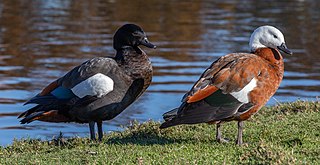
The paradise shelduck, also known as the paradise duck, or pūtangitangi in Māori, is a species of shelduck, a group of goose-like ducks, which is endemic to New Zealand. Johann Friedrich Gmelin placed it in the genus Anas with the ducks, geese, and swans. Both the male and female have striking plumages: the male has a black head and barred black body and the female has a white head with a chestnut body. They weigh between 1.09 and 2 kg and are between 63 and 71 cm in length.

Albert Park is a large public park in the City of Port Phillip, an inner suburban LGA of Melbourne, Victoria, Australia. Located 3 km (1.9 mi) south of the Melbourne central business district, the park encompasses 2.25 km2 of parkland around the 1.8 km (1.1 mi) long Albert Park Lake, a 0.49 km2 Y-shaped artificial lake used both for water sports and public recreation.

The blue-billed duck is a small Australian stiff-tailed duck, with both the male and female growing to a length of 40 cm (16 in). The male has a slate-blue bill which changes to bright-blue during the breeding season, hence the duck's common name. The male has deep chestnut plumage during breeding season, reverting to a dark grey. The female retains black plumage with brown tips all year round. The duck is endemic to Australia's temperate regions, inhabiting natural inland wetlands and also artificial wetlands, such as sewage ponds, in large numbers. It can be difficult to observe due to its cryptic nature during its breeding season through autumn and winter. The male duck exhibits a complex mating ritual. The blue-billed duck is omnivorous, with a preference for small aquatic invertebrates. BirdLife International has classified this species as Least concern. Major threats include drainage of deep permanent wetlands, or their degradation as a result of introduced fish, peripheral cattle grazing, salinization, and lowering of ground water.

The white-necked heron or Pacific heron is a species of heron that is found on most of the Australian continent wherever freshwater habitats exist. It is also found in parts of Indonesia and New Guinea, but is uncommon in Tasmania. The populations of this species in Australia are known to be nomadic like most water birds in Australia, moving from one water source to another, often entering habitats they have not previously occupied, taking advantage of flooding and heavy rain where the surplus of food allows them to breed and raise their young. Irruptive movements may occur when environmental conditions are right in places where the species has been rare or absent.

The Madagascar plover, also known as the black-banded plover, is a small monogamous shorebird in the family Charadriidae, native to western Madagascar. It inhabits shores of lagoons, coastal grasslands, and breeds in salt marshes. These plovers mainly nest in open grassland and dry mudflats surrounding alkaline lakes. The species is classified as vulnerable by the IUCN because of its low breeding success, slow reproductive rate, and weak adaptation to increasing habitat loss, leading to declining population numbers.

The mute swan is a species of swan and a member of the waterfowl family Anatidae. It is native to much of Eurosiberia, and the far north of Africa. It is an introduced species in North America, home to the largest populations outside of its native range, with additional smaller introductions in Australasia and southern Africa. The name "mute" derives from it being less vocal than other swan species. Measuring 125 to 160 cm in length, this large swan is wholly white in plumage with an orange beak bordered with black. It is recognizable by its pronounced knob atop the beak, which is larger in males.

